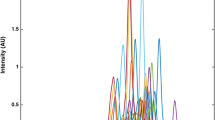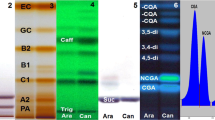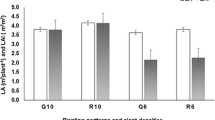Abstract
The alkaloid compositions of 99 green coffee (Coffea arabica L.) bean samples comprising eight varieties (Harar, Jimma, Kaffa, Wollega, Sidama, Yirgachefe, Benishangul and Finoteselam) from the major production regions of Ethiopia were investigated. High performance liquid chromatography was applied for the simultaneous determination of four coffee alkaloids in the aqueous extracts of the beans. The limits of detection for the method were established as 13 mg kg−1 for trigonelline, 7 mg kg−1 for theobromine, 8.5 mg kg−1 for caffeine and 4 mg kg−1 for theophylline in the dry coffee beans. Theophylline was not detected in any of the samples. The determined concentrations (% w/w dry coffee beans) ranged from 0.98 to 1.32 % for trigonelline, 0.0048 to 0.0094 % for theobromine and 0.87 to 1.38 % for caffeine. The concentrations of the alkaloids varied significantly, depending on the geographical origin of the beans. Theobromine was not detected in coffee beans from the East (Harar coffees), and its absence in samples can be used to ascertain whether the coffee originates from this region. Coffee beans from the Northwest were characterized by higher concentrations of caffeine. Application of linear discriminant analysis provided 75 % correct classification of samples into the respective production regions, with a 74 % prediction success rate. The moderate classification efficiency obtained when using alkaloid data demonstrates the potential of using this class of compounds in discriminant models for determination of the geographical origin of green coffee beans from Ethiopia.








Similar content being viewed by others
References
Alonso-Salces RM, Serra F, Reniero F (2009) Botanical and geographical characterization of green coffee (Coffea arabica and Coffea canephora): chemometric evaluation of phenolic and methylxanthine contents. J Agric Food Chem 57:4224–4235
Al-Othman ZA, Aqel A, Alharbi MKE, Badjah-Hadj-Ahmed AY, Al-Warthan AA (2012) Fast chromatographic determination of caffeine in food using a capillary hexyl methacrylate monolithic column. Food Chem 132:2217–2223
Alpdogan G, Karabina K, Sungur S (2002) Derivative spectrophotometric determination of caffeine in some beverages. Turkish J Chem 26:295–302
Amamo AA (2014) Coffee production and marketing in Ethiopia. Eur J Bus Manag 6:109–121
Ascherio A, Weisskopf MG, O’Reilly EJ (2004) Coffee consumption, gender, and Parkinson’s disease mortality in the cancer prevention study II cohort: the modifying effects of estrogen. Am J Epidem 160:977–984
Ashihara H, Sano H, Crozier A (2008) Caffeine and related purine alkaloids: biosynthesis, catabolism, function and genetic engineering. Phys Chem Chem Phys 69:841–856
Belay A, Ture K, Redi M, Asfaw A (2008) Measurement of caffeine in coffee beans with UV/vis spectrometer. Food Chem 108:310–315
Bertrand B, Villarreal D, Laffargue A, Posada H, Lashermes P, Dussert S (2008) Comparison of the effectiveness of fatty acids, chlorogenic acids, and elements for the chemometric discrimination of coffee (Coffea arabica L.) varieties and growing origins. J Agric Food Chem 56:2273–2280
Casal S, Oliveira MBPP, Alves MR, Ferreira MA (2000) Discriminate analysis of roasted coffee varieties for trigonelline, nicotinic acid, and caffeine content. J Agric Food Chem 48:3420–3424
Clifford MN, Kazi T (1987) The influence of coffee bean maturity on the content of chlorogenic acids, caffeine and trigonelline. Food Chem 26:59–69
Crozier A, Clifford MN, Ashihara H (2006) Plant secondary metabolites: occurrence, structure and role in the human diet, 1st edn. Blackwell, Oxford, pp 1–22
Cruz R, Cardoso MM, Fernandes L, Oliveira M, Mendes E, Baptista P, Morais S, Casal S (2012) Espresso coffee residues: a valuable source of unextracted compounds. J Agric Food Chem 60:7777–7784
de Santos WJR, Santhiago M, Yoshida IVP, Kubota LT (2012) Electrochemical sensor based on imprinted sol–gel and nanomaterial for determination of caffeine. Sensors Actuators B 167:739–745
del Campo G, Berregi I, Caracena R, Zuriarrain J (2010) Quantitative determination of caffeine, formic acid, trigonelline and 5-(hydroxymethyl)furfural in soluble coffees by 1H-NMR spectrometry. Talanta 81:367–371
Duarte GS, Pereira AA, Farah A (2010) Chlorogenic acids and other relevant compounds in Brazilian coffees processed by semi-dry and wet post-harvesting methods. Food Chem 118:851–855
Farah A (2012) Coffee: emerging health effects and disease prevention, 1st edn. John Wiley & Sons, Oxford, pp 21–58
Farah A, de Paulis T, Moreira DP, Trugo LC, Martin PR (2006a) Chlorogenic acids and lactones in regular and water-decaffeinated Arabica coffees. J Agric Food Chem 54:374–381
Farah A, Monteiro MC, Calado V, Franca AS, Trugo LC (2006b) Correlation between cup quality and chemical attributes of Brazilian coffee. Food Chem 98:373–380
Gichimu BM, Gichuru EK, Mamati GE, Nyende AB (2014) Biochemical composition within Coffea arabica cv. Ruiru 11 and its relationship with cup quality. J Food Res 3:31–44
Higdon J, Frei B (2006) Coffee and health: a review of recent human research. Crit Rev Food Sci Nutr 46:101–123
Hirakawa N, Okauchi R, Miura Y, Yagasaki K (2005) Anti-invasive activity of niacin and trigonelline against cancer cells. Biosci Biotechnol Biochem 69:653–658
Huck CW, Guggenbichler W, Bonn GK (2005) Analysis of caffeine, theobromine and theophylline in coffee by near infrared spectroscopy (NIRS) compared to high-performance liquid chromatography (HPLC) coupled to mass spectrometry. Anal Chim Acta 538:195–203
Joet T, Laffargue A, Descroix F, Doulbeau S, Bertrand B, de Kochko A, Dussert S (2010) Influence of environmental factors, wet processing and their interactions on the biochemical composition of green Arabica coffee beans. Food Chem 118:693–701
Kalaska B, Piotrowski L, Leszczynska A, Michalowski B, Kramkowski K, Kaminski T, Adamus J, Marcinek A, Gebicki J, Mogielnicki A, Buczko W (2014) Antithrombotic effects of pyridinium compounds formed from trigonelline upon coffee roasting. J Agric Food Chem 62:2853–2860
Kebede M, Bellachew B (2008) Phenotypic diversity in the Hararge coffee (Coffea arabica L.) germplasm for quantitative traits. East Afr J Sci 2:13–18
Kufa T, Ayano A, Yilma A, Kumela T, Tefera W (2011) The contribution of coffee research for coffee seed development in Ethiopia. E3 J Agric Res Develop 1:9–16
Ky C-L, Dussert S, Guyot B, Hamon S, Noirot M (2001) Caffeine, trigonelline, chlorogenic acids and sucrose diversity in wild Coffea arabica L. and C. canephora P. accessions. Food Chem 75:223–230
Lopez-Martinez L, Lopez-de-Alba PL, Garcia-Campos R, De Leon-Rodriguez LM (2003) Simultaneous determination of methylxanthines in coffees and teas by UV–vis spectrophotometry and partial least squares. Anal Chim Acta 493:83–94
Muniz-Valencia R, Jurado JM, Magana SGC, Alcazar A, Diaz JH (2014) Characterization of Mexican coffee according to mineral contents by means of multilayer perceptrons artificial neural networks. J Food Compos Anal 34:7–11
Murthy PS, Naidu MM (2012) Sustainable management of coffee industry by-products and value addition—a review. Resourc Conserv Recycl 66:45–58
Paradkar MM, Irudayaraj J (2002) Rapid determination of caffeine content in soft drinks using FTIR–ATR spectroscopy. Food Chem 78:261–266
Perrone D, Donangelo CM, Farah A (2008) Fast simultaneous analysis of caffeine, trigonelline, nicotinic acid and sucrose in coffee by liquid chromatography-mass spectrometry. Food Chem 110:1030–1035
Petrie HJ, Chown SE, Belfie LM (2004) Caffeine ingestion increases the insulin response to an oral-glucose-tolerance test in obese men before and after weight loss. Am J Clin Nutr 80:22–28
Rodrigues NP, Bragagnolo N (2013) Identification and quantification of bioactive compounds in coffee brews by HPLC–DAD–MSn. J Food Compos Anal 32:105–115
Santos JR, Rangel AOSS (2012) Development of a chromatographic low pressure flow injection system: application to the analysis of methylxanthines in coffee. Anal Chim Acta 715:57–63
Srdjenovic B, Djordjevic-Milic V, Grujic N, Injac R, Lepojevic Z (2008) Simultaneous HPLC determination of caffeine, theobromine, and theophylline in food, drinks, and herbal products. J Chromatogr Sci 46:144–149
Svorc L, Tomcik P, Svitkova J, Rievaj M, Bustin D (2012) Voltammetric determination of caffeine in beverage samples on bare boron-doped diamond electrode. Food Chem 135:1198–1204
Tessema A, Alamerew S, Kufa T, Garedew W (2011) Variability and association of quality and biochemical attributes in some promising Coffea arabica germplasm collections in southwestern Ethiopia. Int J Plant Breed Genet 1–15
Tohda C, Kuboyama T, Komatsu K (2005) Search for natural products related to regeneration of the neuronal network. Neurosignals 14:34–45
Acknowledgments
The authors thank the Ethiopia Commodity Exchange for providing many of the samples used in this study. Bewketu Mehari is also thankful to University of Gondar, Ethiopia, for sponsoring his PhD study.
Author information
Authors and Affiliations
Corresponding author
Ethics declarations
Funding
The University of Gondar, Ethiopia sponsored the PhD study of Bewketu Mehari.
Conflict of Interest
Bewketu Mahari declares that he has no conflict of interest. Mesfin Redi-Abshiro declares that he has no conflict of interest. Bhagwan Singh Chandravanshi declares that he has no conflict of interest. Minaleshewa Atlabachew declares that he has no conflict of interest. Sandra Combrinck declares that she has no conflict of interest. Rob McCrindle declares that he has no conflict of interest.
Ethical Approval
This article does not contain any studies with human participants or animals by any of the authors. This is an original research article that has neither been published previously nor considered presently for publication elsewhere. All authors named in the manuscript are entitled to the authorship and have approved the final version of the submitted manuscript.
Informed Consent
Not applicable.
Rights and permissions
About this article
Cite this article
Mehari, B., Redi-Abshiro, M., Chandravanshi, B.S. et al. Simultaneous Determination of Alkaloids in Green Coffee Beans from Ethiopia: Chemometric Evaluation of Geographical Origin. Food Anal. Methods 9, 1627–1637 (2016). https://doi.org/10.1007/s12161-015-0340-2
Received:
Accepted:
Published:
Issue Date:
DOI: https://doi.org/10.1007/s12161-015-0340-2




